How To Disable Comments In WordPress
Sometimes you don’t want to hear from your website readers – in this tutorial we show you to disable comments in WordPress

Last Updated: November 23rd, 2021
By: Steve
Contents
Why Disable Comments In WordPress?
There’s a number of reasons you might want to disable comments on WordPress. Perhaps your website is a business site and its aim is merely to provide information to prospective customers. Having a page with your portfolio on it doesn’t necessarily need people to comment. This is particularly so when the likelihood of your website getting legitimate comments is almost nil. This means then that the only comments you’ll be getting will be spam. Managing spam takes time, so disabling comments removes this need.
You may decide that you need comments on certain sections of your website but not others. We can show you how to switch off comments for specific areas of your WordPress site too.
Since WordPress is primarily a blogging system rather than a CMS (Content Management System) the comments system is rather embedded and it can be a bit awkward to remove fully. But with the tricks in this post, we’ll sort you out.
Disable Comments On New Posts
If you’re just starting your new WordPress site this is the best time to switch off the ability for your readers to leave comments. This is because you don’t currently have any comments. Deleting existing comments isn’t therefore a problem. This is also the quickest solution.
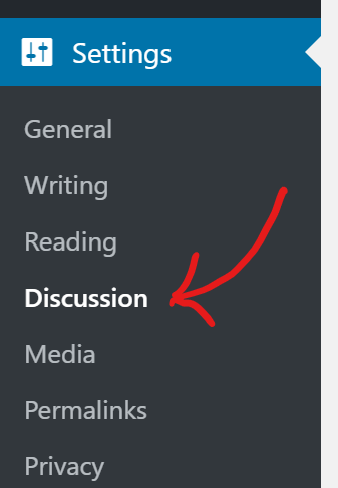
To achieve this, login to your WordPress control panel and choose the Settings menu item from the left hand side. This will open up the Settings sub-menu. From there you need to choose Discussion.
This will then take you to the Settings screen that will enable you to set various different options for the Comments section.

In the screenshot above you can see I’ve taken the tick mark out of the box allowing people to post comments on new articles. I’ve left the other two boxes checked in this example, but in reality you’ll probably want to un-tick them too.
Historically the pingbacks and trackbacks were quite good but very few websites publish them any more. If you want to know what pingbacks and trackbacks are, we’ll have an article about them shortly.
Click the Save button at the bottom of the screen and any future articles you write will no longer have a form for someone to enter a comment.
Disable Commenting On Existing Posts
If you’ve been running your WordPress website for a while and have only just decided to do away with comments then you will need to perform the step above to stop any future posts being commented on. But what about past posts? WordPress is a little bit quirky here. The change you made to commenting doesn’t affect existing content. So to make sure that other posts are unable to have comments left we need to do something a little more. Fortunately, it is possible without adding a plugin.
Find Your Existing WordPress Posts To Modify
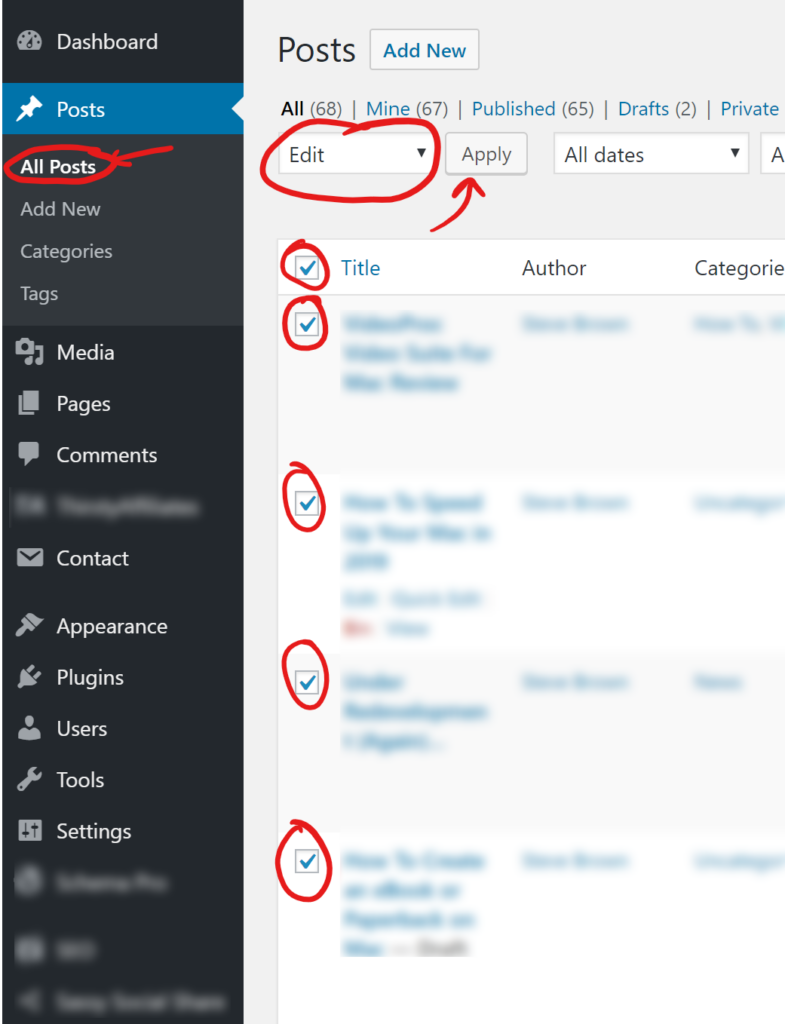
To do this, go to Posts -> All Posts and put a tick mark next to all the posts that you wish to disable comments on. The screenshot to the left gives you an idea of how to do this.
You can just put a tick in the box at the top next to Title in order to select all the available posts. Bear in mind though that if you have lots of posts, they may spread over multiple screens so you’ll need to make sure you click through all the different screens once you’ve done the first one.
Once all that is done, click the drop down list at the top (where the big red circle is in my image) and change it to Edit. Then click the Apply button. This will let you bulk edit all the articles in one go.
Make Changes In The Bulk Editor
When you click the Apply button your WordPress screen will change and you’ll see some additional input boxes and activities you can perform. The screenshot below shows you what it will look like after you hit apply.
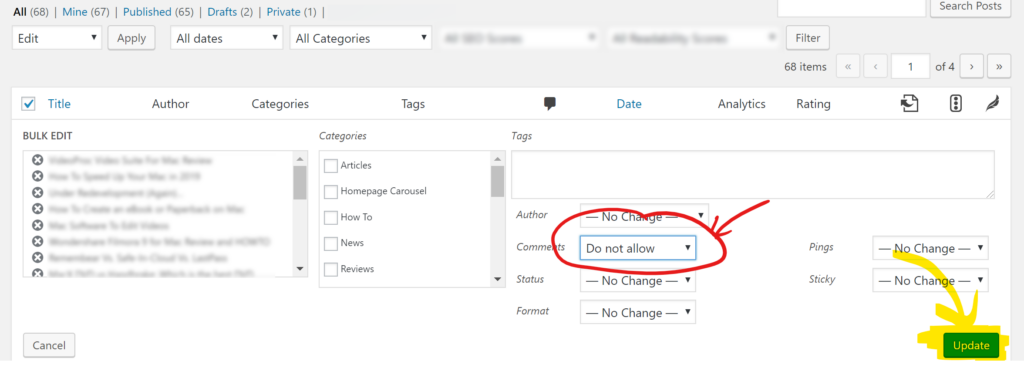
On the left hand side of the screen you can see all the posts that these changes will apply to. You can remove any particular post if you decide that you do still want comments allowed for that article. Simply click the cross next to the article name and it’ll be removed from the list.
Once you’re happy that you definitely want comments disallowed for those articles, move your mouse over to the area I’ve highlighted with a red circle and arrow. Change the default option of ‘No Change’ to ‘Do Not Allow‘. You can also change Pings to Do Not Allow as well if you desire. Once you’re happy with the bulk changes, click the Update button which I’ve highlighted in yellow.
Then – all your existing posts will no longer allow comments either.
Deleting Comments From Existing Posts
The guide above shows you how to stop comments being left on WordPress posts but it doesn’t remove any existing comments. There may be times where you just want to remove the whole notion of commenting from your WordPress website completely. Fortunately, removing existing comments is pretty straightforward too.
Navigate to the Comments page by clicking on the menu option in the left hand toolbar. Then choose the comments you wish to remove – or click the tick box next to the Author to select them all. Then choose Move To Bin or Move To Trash (if you have American English setup on your WordPress installation). All the comments will be deleted. The screenshot below gives you an idea of what to look for.
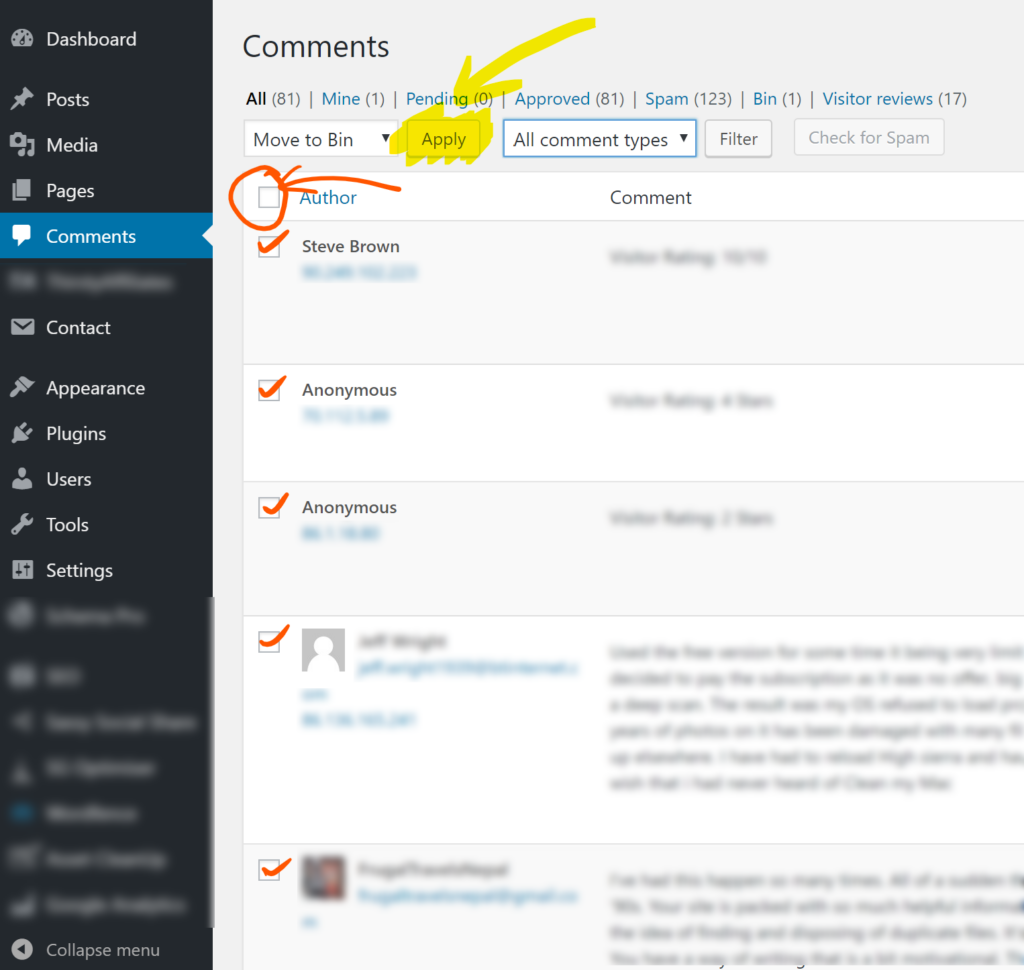
You may decide that you want to keep some comments but delete some. To do that, just select the specific comments you want to delete using the checkboxes and hit Apply when you have the ones selected that you want to move to the trash. You may find you need to do this a few times if your site has lots of comments as WordPress will only show 20 comments at a time. You may also need to skip to the next screen if you’re keeping lots of comments but want to delete others.
That’s it – if you’ve followed all the steps, your new content won’t allow comments. Your old content won’t allow comments. And your existing content will have the comments removed.
Re-Allow Comments On Certain Posts
Of course, it may be that you want comments disabled on new posts but want to be able to override that for certain posts.
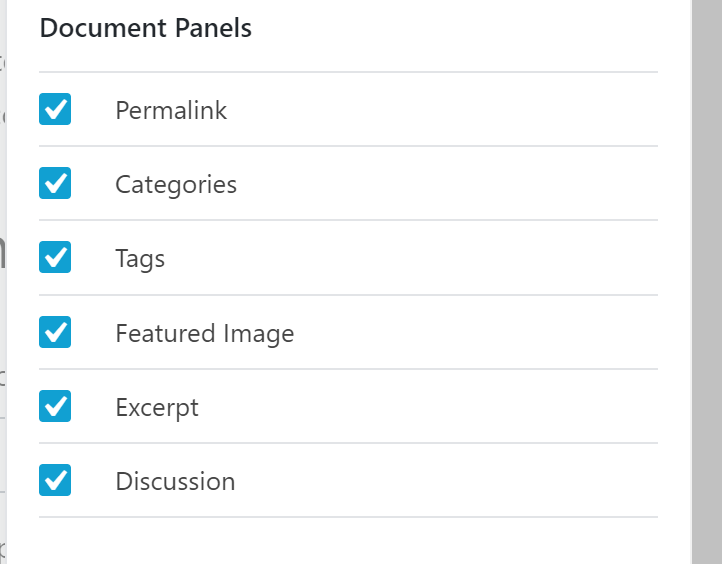
You can allow comments for certain posts when you’re writing them. To be able to see the option in the editor you’ll need to make sure you have your editing environment set to show the Discussion options. To do this, click the 3 vertical dots in the right hand corner of the screen while you’re editing a WordPress document. Choose Options. This will bring up a small panel like the one on the right.
Make sure Discussion is ticked.
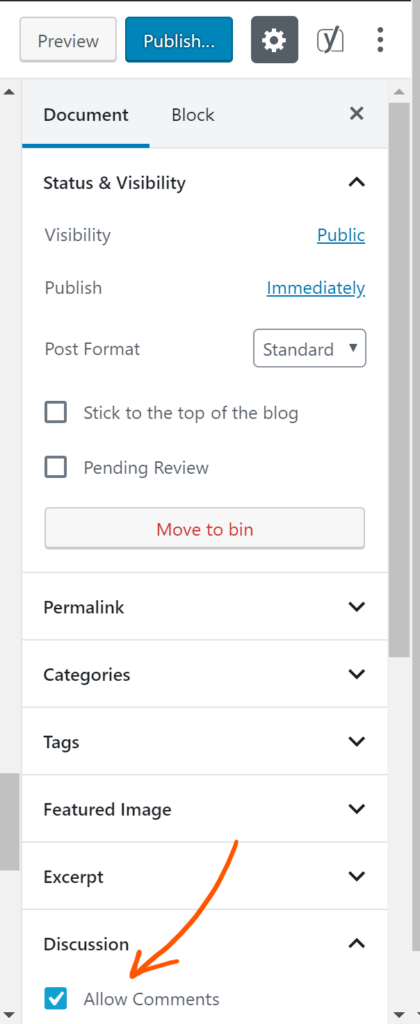
Once you have checked that tickbox you need to click on the Document tab on the right hand toolbar. This will show you the various options that apply to the whole WordPress document (whether it be a page or a post).
You can see from the screenshot to the left what it looks like and hopefully this guides you quickly to where you need to be.
If you want comments enabled for this particular post then just pop a tick in the box marked Allow Comments. You can also decide if you want to allow Pingbacks.
That’s it. Using this method you can decide that you want most articles not to allow comments but some specific ones to allow commenting.
Stopping Comment Spam On WordPress
If your website is one whereby you would prefer to have comments switched on, but you’re being overwhelmed by spammers, then there are things you can do to help this.
If comments don’t make sense for your site, then by all means disable them using the techniques above. But if user interaction is something that makes sense – such as on a site like this one – then anti-spam techniques are worth investigating.
We’ll look in detail at the different anti-spam plugins and techniques that you can use to stop comment spam on WordPress in a future article.
If you’ve enjoyed this article or have any feedback for us, please leave us a message below. We look forward to hearing from you!


